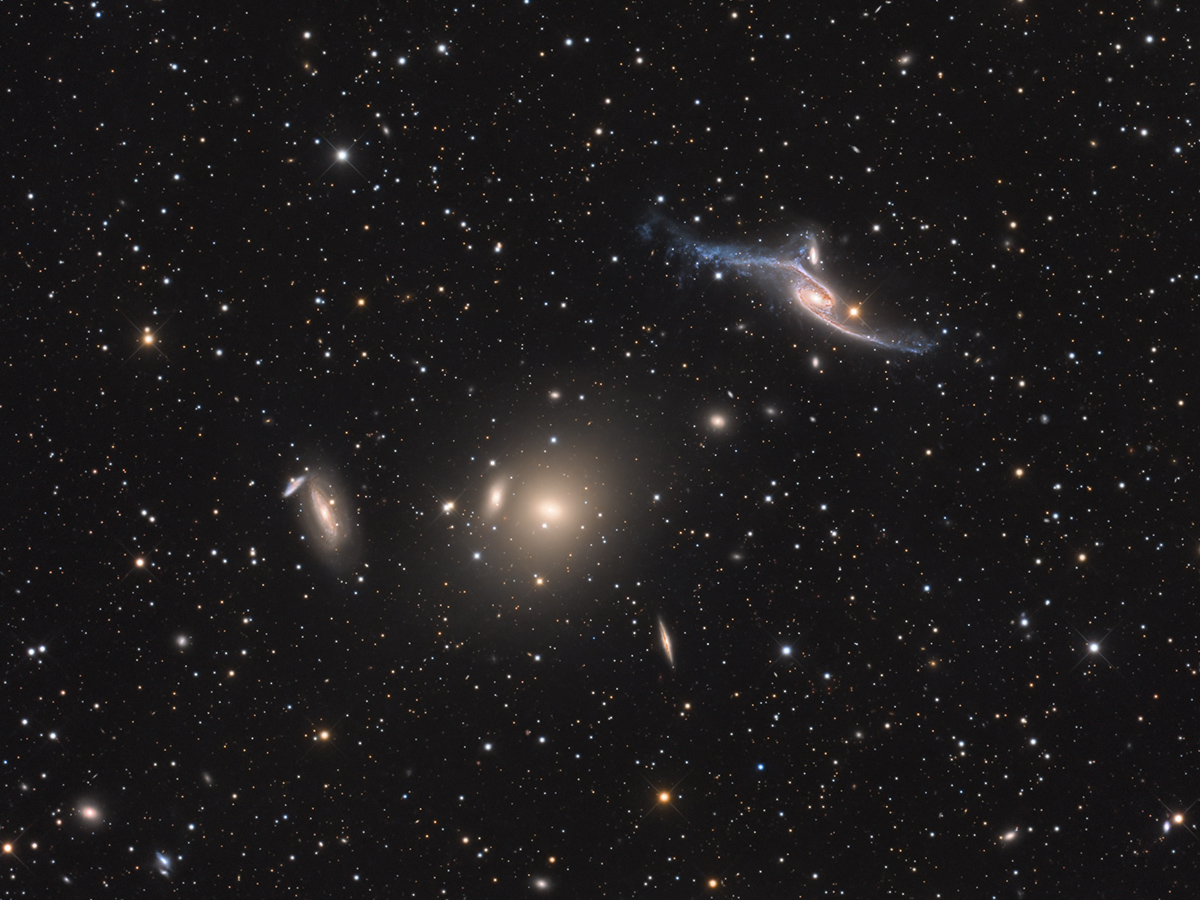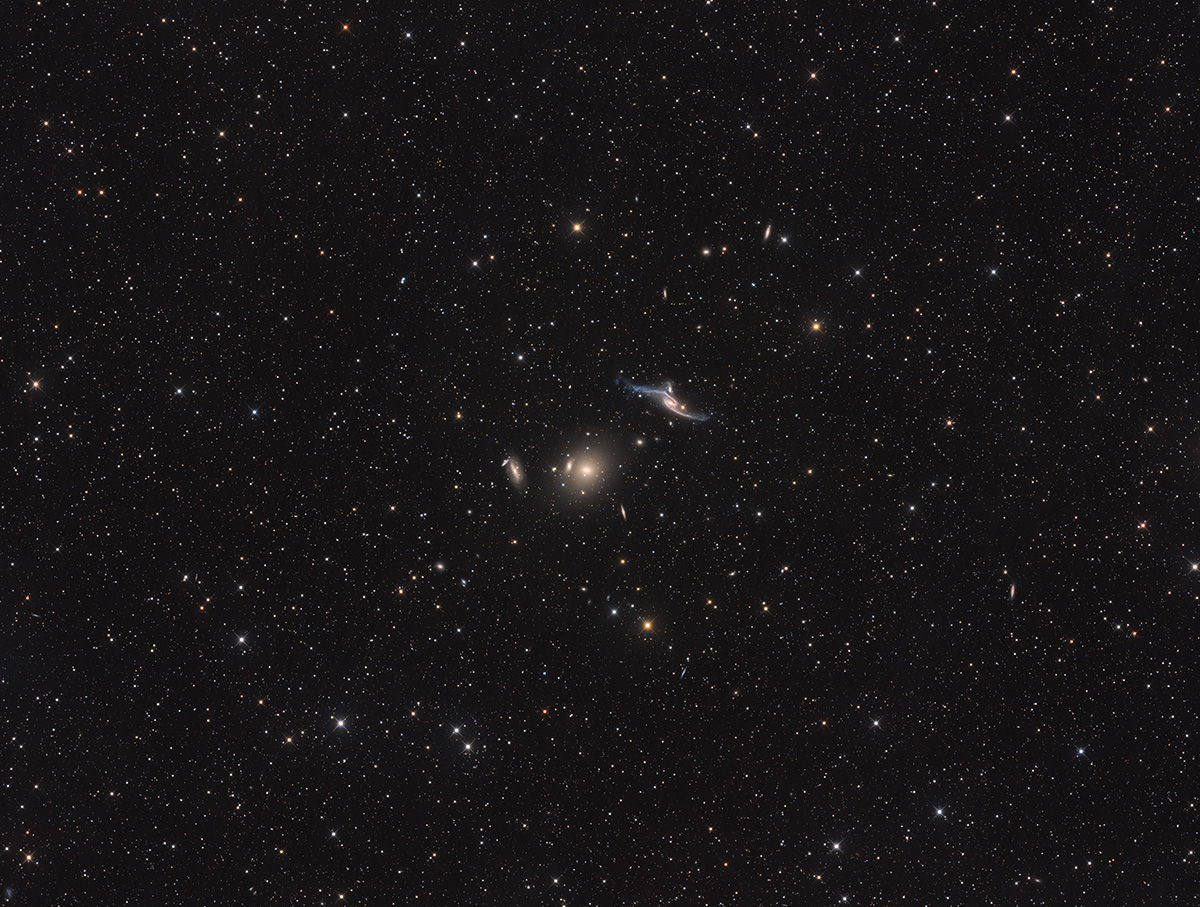
[back]
NGC 6872 et al. in Pavo
[NED]
Higher resolved image / höher aufgelöstes LRGB-Bild (7809 x 5901 Pixel, 0.74"/pixel)
Higher resolved center image / höher aufgelöstes LRGB-Bild des Zentrums (2480 x 1860 Pixel)
Anotated Version / beschriftete Version
Cropped Center

|
300" |
|
(c) 2025 All astro photo images are copyrighted. They may not be used or reproduced without explicit written permission from the authors.
.
Complete field

|
300" |
|
(c) 2025 All astro photo images are copyrighted. They may not be used or reproduced without explicit written permission from the authors
About this Image / Über dieses Bild
| Camera: | Moravian C3-PRO-61000 Mono CMOS |
| Image Type, Orientation: | LRGB Composite, North is at 12:00 |
| Exposure time: | L: 65x300s, R: 42x300s, G: 37x300s, B: 39x300s, Ha: 26x900s (15:30h total) |
| Exposure date: | July 1st...August 1st, 2025 |
| Location: | Capella Observatory South at Kiripotib Astro Farm, Namibia |
| Filter: | Astronomik Deep-Sky Deep-Sky RGB Filter on Moravian EFW-3L-9-II External Filter Wheel |
| Instrument: | "Rhea", a PlaneWave DeltaRho 350, 1050mm focal length, 350mm aperture, f/3 on 10Micron GM2000 HPS II Combi |
| Photographer: | Rainer Raupach, Stefan Binnewies, Frank Sackenheim, Josef Pöpsel |
| Remarks: |
The image
looks into the interior of the Pavo Galaxy Group with the three interacting
galaxy pairs NGC 6872/IC 4970, NGC 6876/NGC 6877, and NGC 6880/IC 4981
(viewed from top right to bottom left). The perspective from which we
observe the SAB(rs)c galaxy NGC 6872 is difficult to describe clearly, as
its horizontal extension would suggest an edge-on view, but we are looking
almost head-on at the inner ring where the two large spiral arms begin. NGC
6872 measures 6.0 x 1.7 arcminutes, and at a distance of 200 million
light-years, this corresponds to a physical size of 630,000 x 130,000
light-years. These enormous dimensions for an SAB galaxy are due to
disturbances in the group, primarily from its companion IC 4970. This
companion is 65,000 light-years away and orbits the galaxy NGC 6872 at a
speed of 160 km/s. The core of NGC 6872 is bright, its bar is faint, and the
upper, northern spiral arm still shows traces of a 120° angle of
Vorontsov-Velyaminov series. However, this disturbance is being destroyed by
the tidal interaction taking place, causing the spiral arms to be pulled
even further apart. An image of the region done with Ganymed in primary focus 20 years before can be found here. |
|
|
|
| Bemerkungen: |
Die Aufnahme blickt ins Innere der
Pavo-Galaxiengruppe mit den drei wechselwirkenden Galaxienpaaren NGC 6872/IC
4970, NGC 6876/NGC 6877 und NGC 6880/IC 4981 (von oben rechts nach links
unten betrachtet). Die Perspektive unter der wir die SAB(rs)c-Galaxie NGC
6872 beobachten ist nicht klar zu beschreiben, da ihre waagrechte Ausdehnung
auf eine Kantenlage schließen ließe, den inneren Ring aber, an dem die zwei
großen Spiralarme ansetzen, betrachtet wir fast frontal. NGC 6872 misst 6.0
x 1.7 Bogenminuten und aus der Entfernung von 200 Millionen Lichtjahren
ergibt sich eine physikalische Größe von 630.000 x 130.000 Lichtjahren.
Diese riesigen Ausmaße für eine SAB-Galaxie gehen auf Störungen in der
Gruppe zurück, vor allem durch den Begleiter IC 4970. Dieser steht in 65.000
Lichtjahren Abstand und umläuft mit einer Bahngeschwindigkeit von 160 km/s
die Galaxie NGC 6872. Der Kern von NGC 6872 ist hell, ihr Balken schwach
ausgeprägt, und der obere, nördliche Spiralarm zeigt noch Spuren eines 120°
Winkels von Vorontsov-Velyaminov Reihen. Jedoch wird diese Störung durch die
stattfindende Gezeitenwechselwirkung wieder zerstört und die Spiralarme
werden dadurch noch weiter auseinandergezogen. Text aus dem Bildatlas der Galaxien von Michael König und Stefan Binnewies, erschienen im KOSMOS-Verlag. |
Back to the Galaxies' Overview / Zurück zur Galaxien-Übersichtsseite